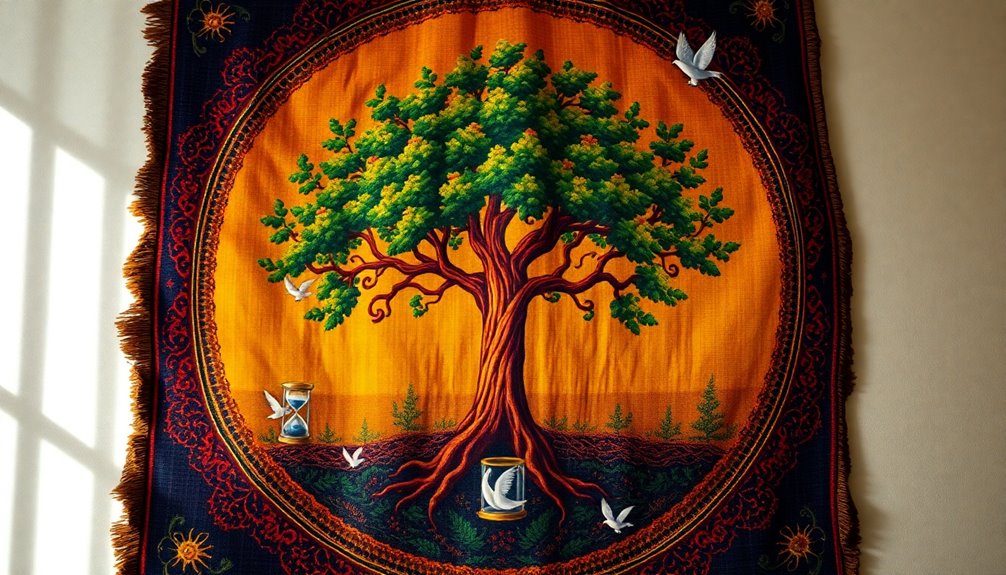Symbolism adds layers of meaning to stories, making them much more exciting! When you spot a symbol, like a rose for love or a heart for friendship, it helps you connect with the characters and themes on a deeper level. Symbols can even show how characters grow or change throughout the story. Plus, understanding symbolism lets you see complex ideas and emotions in a simpler way. By recognizing and interpreting these symbols, you reveal hidden messages that keep you engaged and curious. There's so much more to discover about how symbols change meaning, so keep exploring to find out more!
Key Takeaways
- Symbolism conveys deeper meanings and emotions beyond literal interpretation, enhancing narrative richness.
- It establishes connections between characters and themes, conveying complex ideas simply.
- Symbols can foreshadow events and reveal character traits, enriching storytelling.
- Repeated symbols evolve into motifs, reinforcing central themes throughout a narrative.
- Understanding symbols allows readers to grasp complex ideas and character dynamics more effectively.
Definition of Symbolism

Symbolism is a powerful tool in art and literature that uses symbols—objects, images, or characters—to convey meanings that go beyond their literal interpretation. When you explore symbolism, you discover how colors can express emotions or how a character might represent a larger idea. For example, a red rose often symbolizes love. This color choice isn't just about beauty; it carries deep feelings and connections.
Symbols can vary widely in meaning based on cultural contexts. What's a universal symbol in one culture might mean something entirely different in another. That's what makes symbolism so fascinating! It engages both your senses and thoughts, helping you understand themes and emotions on multiple levels.
Effective symbolism uses familiar signs to represent complex ideas in a simple way. This allows you to connect personally with the story or artwork. When you recognize these symbols, you're not just seeing objects; you're uncovering layers of meaning. Each symbol you encounter adds richness to your experience, making it more exciting and enjoyable.
Importance of Symbolism in Writing

In writing, the importance of symbolism can't be overstated, as it enriches narratives and deepens the reader's experience. When you use symbols, you allow your audience to connect with complex ideas and emotions through concrete images. This makes your story more engaging!
Think about how symbols carry symbolic meaning. They help establish connections between characters and themes, showing readers deeper messages without needing to explain everything outright. For example, a storm might symbolize chaos in a character's life or a rose could represent love.
Using this literary device effectively can also foreshadow events or reveal character traits. Imagine a character always carrying a broken clock; it hints at their struggle with time and responsibility. Repeated symbols can turn into motifs, which reinforce central themes throughout your story.
Most importantly, symbolism encourages readers to interpret and connect personally with your work. They can discover their meanings from the text, leading to a richer experience.
Types of Symbolism

How do different types of symbolism enhance storytelling? Understanding these types of symbolism can make your reading experience even richer!
First, there's universal symbolism, which many people recognize across cultures. For example, a heart often symbolizes love, while water can represent life. These symbols help everyone connect with a story, no matter where they're from.
Next, we've contextual symbolism. This type takes its meaning from the story's setting. For instance, a silver locket might symbolize family heritage in one tale, but mean something different in another.
Color symbolism is also important! Colors can evoke emotions and ideas. Red usually stands for passion or anger, while blue can represent calmness or sadness. Sometimes, the meaning can change based on cultural backgrounds.
Lastly, there's accidental symbolism. This happens when objects gain meaning through personal experiences. A childhood toy might symbolize lost innocence for a character, making the story more relatable.
Recognizing Symbols in Literature

Recognizing symbols in literature can transform your reading experience, allowing you to uncover deeper meanings woven into the narrative. When you spot symbols, like a red rose or a stormy sky, you're seeing more than just words on a page. These symbols often carry deeper messages or emotions that the author wants you to feel.
Understanding the context is key—sometimes the same symbol can mean different things based on where it appears or which character interacts with it.
As you read, pay attention to how certain symbols repeat throughout the story. These motifs can reveal important themes and help you connect emotionally with the characters. You might even find that after re-reading a book, those symbols stand out more clearly, allowing you to see layers you missed before.
Also, consider how each character views the symbols. Different characters might see the same object in various ways, providing insights into their personalities and conflicts.
Interpreting Symbolic Meanings

Symbolism enriches literature by allowing you to grasp complex ideas and emotions quickly. When you read, you might notice that symbolism refers to objects, colors, or actions that stand for something deeper. The interpretation of symbols is important for understanding the story fully. For example, a red rose might symbolize love in one culture, while in another, it could mean danger. Recognizing this cultural context can really change how you see a symbol.
In your own writing, using symbolism can help convey your thoughts more clearly. Think about the symbols you choose and how they can add layers to your story. Sometimes, a symbol can evolve throughout the narrative. A sunny day might start as a symbol of happiness but later represent loss or regret.
As you read, pay attention to how symbols appear and reappear. This repetition can help you discover the themes and emotions behind the characters. It's like peeling back layers of an onion!
Contextual Factors in Symbolism

Many factors shape the interpretation of symbols in literature, including the author's cultural background and the time period in which the work was created. Understanding these contextual factors is essential for grasping the full meaning of the symbols. For instance, symbols might change as the story unfolds, and their significance often depends on the narrator's perspective. This means that what one character sees might not be the same for another.
Here's a quick look at how different factors influence symbolism:
| Contextual Factor | Example | Impact on Symbolism |
|---|---|---|
| Author's Background | A writer from Japan | Colors like red can symbolize luck. |
| Time Period | 1920s America | The color green might represent wealth. |
| Narrator's Perspective | An unreliable narrator | Symbols may mislead readers or seem biased. |
Cultural understanding is key here! The same symbol can have various meanings across cultures. By recognizing these factors, you'll uncover deeper themes and insights about characters, making your reading experience richer and more enjoyable. So, keep these ideas in mind as you immerse yourself in the world of symbolism!
Symbolism vs. Motif

Often, readers confuse symbolism with motifs, but understanding the distinction can enhance your appreciation of a text. Both are important tools in storytelling, but they serve different purposes.
- Symbolism uses specific objects, colors, or images to represent larger ideas or themes.
- Motifs are recurring elements that reinforce the central themes throughout a work.
- Symbols can be unique to particular moments or characters, while motifs grow in significance through repetition.
- While symbolism invites deeper analysis, motifs provide a consistent structure.
Think about the main character in your favorite story. If their favorite color symbolizes their emotions, that's symbolism at work!
On the other hand, if a certain phrase keeps popping up, creating a rhythm in the story, that's a motif.
Examples of Symbols in Literature

Throughout literary history, symbols have played an essential role in conveying complex themes and emotions. These symbols help us understand deeper meanings behind stories.
For example, in F. Scott Fitzgerald's "The Great Gatsby," the green light at the end of Daisy's dock symbolizes Gatsby's unreachable dreams. It shows how he longs for something just out of reach.
In William Golding's "Lord of the Flies," the conch shell represents civilization and order. When it breaks, it symbolizes the collapse of society. This shift shows how quickly things can change.
Sylvia Plath's poem "The Colossus" features a statue that symbolizes the speaker's broken relationships with her father and husband. It reflects feelings of loss and identity.
In Shakespeare's "Macbeth," blood symbolizes guilt, highlighting the psychological torment the characters endure.
Lastly, in Toni Morrison's "Beloved," the ghost symbolizes the haunting legacy of slavery. It illustrates the struggle for identity and redemption after trauma.
Each symbol offers a glimpse into the characters' emotions and the broader themes of the story. When you read, think about how these symbols can deepen your understanding of the characters and their journeys!
How to Use Symbolism Effectively

Symbols enrich narratives by adding layers of meaning, but using them effectively requires thoughtfulness. When you're diving into creative writing, consider these tips for using symbols:
- Choose meaningful symbols that resonate with your story's themes, like a recurring object that reflects a character's emotional journey.
- Think about cultural meanings. Different cultures view symbols in unique ways, so guarantee your symbols convey the right message to your audience.
- Use concrete imagery when introducing symbols. Specific details can create vivid connections and evoke strong emotions in your readers.
- Let symbols evolve. As your characters develop and the plot progresses, allow the meanings of symbols to change, adding depth to your narrative.
Remember to avoid obvious symbolism that feels forced or overly subtle symbols that confuse. Aim for a balance where your symbols are both meaningful and open to interpretation.
This approach will enrich your readers' experience and enhance character development. With these strategies, you'll create stories that resonate and linger in the minds of your audience. Happy writing!
Common Misinterpretations of Symbols

When readers approach a text, they may mistakenly assume that symbols have a singular meaning, neglecting the rich context surrounding them. This misinterpretation of symbols can lead to confusion, especially when cultural differences come into play. What means one thing in one culture might represent something entirely different in another. It's important to pay attention to these contexts!
Sometimes, readers get so excited about finding symbols that they overanalyze them. This can create false symbolism, where you might see meanings the author never intended. For example, taking a character's favorite object literally can overshadow its true symbolic value.
Additionally, characters can project their own feelings onto symbols, leading to conflicting symbolic meanings. This means that the same symbol can represent different things to different characters, adding layers of meaning.
Frequently Asked Questions
What Was the Purpose of Symbolism?
The purpose of symbolism is to help you understand deeper meanings in stories or poems. When a writer uses symbols, they're connecting ideas and feelings in a special way.
For example, a heart might stand for love, while a storm can represent trouble. This makes reading more exciting! You get to explore and discover what these symbols really mean.
It invites you to think, feel, and see the story from different angles.
What Does Symbolism Do to the Reader?
Symbolism makes reading so much fun! When you spot a symbol, it's like finding a treasure hinting at deeper meanings. It helps you connect with characters and themes in a personal way. You might feel emotions or reflections that surprise you.
Plus, when symbols repeat, they create patterns, guiding your understanding. Each reader can interpret symbols differently, bringing their own experiences into the story. This makes every reading unique and exciting!
What Is the Purpose of Symbolization?
Symbolization's spectacular purpose is to simplify complex ideas, making them easier to understand.
It helps you connect with stories and art on a personal level. By using symbols, creators can express feelings and themes that resonate with you.
You'll find that symbols often pop up throughout a story, linking important ideas together. This makes the experience more exciting and meaningful, allowing you to discover hidden messages and universal truths!
What Is the Purpose of Symbolic?
The purpose of symbolism is to add meaning and depth to stories. When you notice a symbol, like a red rose, it often stands for love or passion.
Symbols let you explore big ideas without using many words. They can make you feel emotions, connect with characters, and reflect on important themes.
You get to interpret these symbols, making the story more personal and exciting. Isn't it fun to discover what they mean?
Conclusion
So, now you know what symbolism does! It adds layers of meaning and makes stories even more exciting. Isn't it funny how something as simple as a rose can mean love, or even something deeper? By using symbols, writers invite you to explore and think. Next time you read, keep an eye out for these hidden treasures. Who knew that a little symbol could hold so much power? Happy reading, and enjoy uncovering the magic of words!











